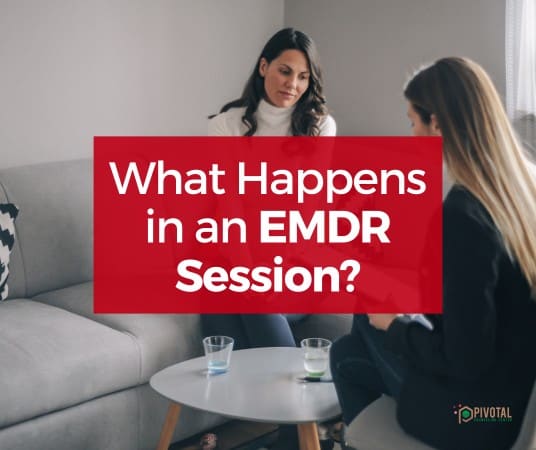
Have you ever heard of EMDR?
Eye Movement Desensitization and Reprocessing, or EMDR, is a type of trauma therapy that has become more well known in the past decade. It’s a highly researched and effective form of therapy that was developed as a way to heal from trauma and distressing memories. In addition to being an effective trauma treatment, EMDR can help with anxiety, depression, phobias, chronic pain, grief, eating disorders, and substance use.
Understanding the Basics of EMDR
EMDR works to help the brain process trauma. You know how your body has a process to heal wounds? The theory behind how EMDR works is similar – that our brains have the ability to recover from trauma. EMDR helps facilitate this recovery by reprocessing disturbing memories that were not processed adequately by your brain in the past, which lessens the distress you feel when recalling those experiences.
EMDR uses bilateral stimulation (BLS), including eye movements, tapping, and sounds, to encourage your brain to effectively reprocess those disturbing memories so you no longer feel the distress you once experienced when thinking about them.
EMDR is different from traditional talk therapy because it doesn’t require you to talk extensively about traumatic memories. It also tends to work much faster than traditional talk therapy, which can be motivating. EMDR works well in conjunction with talk therapy, so you have a space to process trauma and distress with EMDR and then a space to unpack everything else.
The Phases of EMDR Therapy
There are 8 different phases within the EMDR therapy process. They are:
History & Treatment Planning
This phase encompasses the initial sessions with your therapist, where you discuss your history to help guide your course of treatment. In this phase you will likely identify some key issues or triggers you’d like to work on in your sessions, and discuss your goals for the future.
Preparation
In phase 2, you’ll learn grounding techniques and coping strategies to help support you throughout the process. Your therapist will explain how EMDR works, and exactly what to expect in each session. They’ll help you practice strategies for managing your emotions and teach you how to do the bilateral stimulation that you’ll use in the desensitization and reprocessing phase.
Assessment
In phase 3, you’ll select, with the help of your therapist, the distressing memory to target in your session. Your therapist will help you assess the different components of the memory, and you’ll measure your level of distress using a scale called the Subjective Units of Distress. You’ll also identify negative beliefs you have that are tied to the distressing or traumatic memory, and pick out positive replacement beliefs to install going forward.
Desensitization & Reprocessing
This is the phase where you start to use bilateral stimulation. In phase 4, you’ll hold an image of the distressing memory in your mind while tapping or moving your eyes side to side. Your therapist will guide you through the tapping and encourage you to notice the thoughts, images, and body sensations that accompany the memory. During this phase, the distress around the memory will typically go down.
Installation of Positive Beliefs
In the next phase, you’ll start replacing the negative beliefs you hold around this distressing memory with the positive beliefs you selected in phase 3. You’ll also use bilateral stimulation during this phase.
Body Scan
In this phase, you’ll check your body for any signs of lingering distress from the memories you’re targeting. You’ll use body awareness techniques explained to you in phase 2 to measure the progress of desensitizing the painful memory, and use bilateral stimulation to process any residual distress in the body.
Closure
Each reprocessing session will end with something called closure to help you ground your emotions and prepare to leave the session. This portion of the session will also include a discussion of how you might feel after your session and how to handle the emotions that may come up before your next session.
Reevaluation
The final phase of EMDR will actually be the first thing you do at your next session after reprocessing. In this phase, your therapist will start the session by reviewing your progress and deciding whether more EMDR is needed.
What to Expect Emotionally During an EMDR Session
An EMDR session usually lasts 60-90 minutes, and they can be in person or online. In the first two phases, sessions will resemble a more traditional talk therapy session, while your therapist learns your history, plans your treatment and teaches you resources to help with the emotions that are activated during EMDR. Once you get to phase three, you will begin to focus on specific distressing memories to reprocess, and phases 4-7 will make up the remainder of your session.
During EMDR sessions, you may experience intense emotional reactions due to the distressing memories and how reprocessing works. It’s common to cry, experience emotions like anger, grief, shame, guilt, relief, overwhelm, or even numb. It’s also likely that you’ll experience physical sensations in your body as a result of these emotions, which your therapist will help you notice during the Body Scan portion of EMDR.
After an EMDR session, you may feel extremely tired or emotional. You might experience relief or you might experience some of the emotions you felt during your session. This is why it’s important to feel confident using the coping skills you learned in phase 2 to help you feel more grounded and contain your distress until your next session with your therapist.
How to get the most out of your EMDR session
Studies show that the most important part of the therapeutic process is the alliance between the client and therapist, so make sure to choose someone that you like and trust. Remember that EMDR happens in stages, so be patient with the process.
It’s also helpful to practice self-care between your EMDR sessions, and to reference coping skills and grounding techniques that your therapist taught you in the Preparation phase. In addition, make sure to bring up any concerns with the process to your therapist! They are there to guide you through the process and are happy to help you with any questions or concerns you may have.
If you’re looking for expert mental health help, including EMDR therapy, in Lake in the Hills, Elgin, or Woodstock, Illinois, our community of therapists is here to support you. Get in touch today to get started.
Pivotal Counseling Center is now accepting Medicaid including Blue Cross Community Medicaid, Meridian Medicaid, and Molina Medicaid for outpatient counseling.








